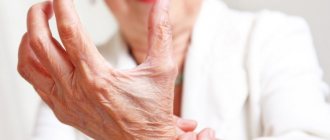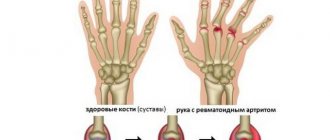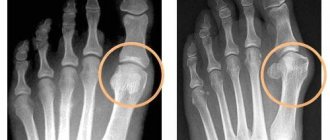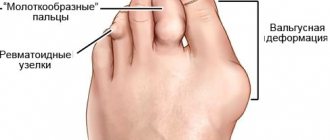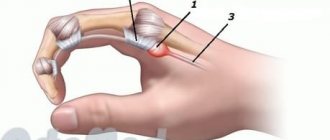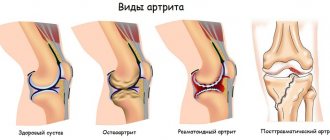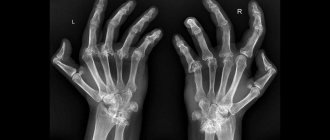Video
- Joint pain. Question answer. Topic: Encyclopedia of diseases
- Joint pain Topic: Encyclopedia of diseases
Title
- Major diseases
- Myths and facts
- Diagnostics
- Treatment methods
Joint pain can be mild in intensity or severe and debilitating. Over the course of their lives, up to 85% of the adult population will experience joint pain in one way or another. The cause of joint pain can be hundreds of diseases, in which joint damage can be either primary or secondary (due to intoxication with metabolic products).
The following diseases are most often accompanied by joint pain:
- Osteoarthritis
- Rheumatoid arthritis
- Rheumatism
- Reactive arthritis
- Psoriatic arthritis
- Bursitis
- Gout
- Myeloma
- Lyme disease
- Osteomyelitis
- Systemic lupus erythematosus
- Scleroderma
- Lymphoblastic leukemia
- Sarcoidosis
- Kawasaki disease
- Crohn's disease
- Still's disease
- Bone metastases
- Septic arthritis
Statistically, 4 diseases with the presence of arthralgia (joint pain) deserve the most attention.
Osteoarthritis
Arthritis (inflammation of the joint) is the most common cause of joint pain and a very large number of people suffer from this disease. Osteoarthritis is sometimes called degenerative, meaning that the cartilage tissue lining the surfaces of the joint undergoes degenerative changes over time and damaged cartilage injures each other, causing symptoms such as joint pain, inflammation, stiffness and limited mobility. Osteoarthritis affects approximately 27 million people in the United States. Symptoms usually begin after age 40 and progress slowly. And after the age of 60, up to half of people experience this disease to one degree or another. Osteoarthritis most often affects large joints that are subject to greater stress (hips, knees and ankles). Increased weight increases the risk of this disease. It has been noted that people with increased weight (both men and women) are three times more likely to develop this disease compared to people with normal weight (the same age and gender group).
Prevention of joint disease
Proper nutrition ensures health to all body systems. A sufficient amount of protein, calcium, iron and vitamins allows you to provide cartilage tissue, ligaments, synovial fluid and bones with everything they need.
In addition, an active lifestyle will keep your muscles toned, thanks to which they provide additional support to the entire skeleton in general, and joints in particular. And in order to protect yourself from dangerous viral infections that affect the joints, you need to be vaccinated in a timely manner.
Rheumatoid arthritis
An autoimmune disease that causes pain and stiffness in the joints. Most often it occurs in women aged 20 to 50 years. There are about 1.5 million patients with this diagnosis in the United States. In patients with this disease, due to disruption of the immune system, antibodies are formed to their own tissues (including joint tissues), which causes inflammatory processes and manifests itself as damage to joints and other internal organs. Inflammation in the joints leads to rapid wear, pain and limited mobility. Due to the fact that the disease is systemic and autoantibodies spread throughout the body, joint damage is symmetrical (joints on the right and left are affected). Small joints (in the hand and foot) are often affected, as well as large joints.
Why do joints hurt?
Joints are located at the junction of bones and provide motor and support functions.
A person has 38 such points. There are a total of 76 joints in the body. Their defeat leads to limited mobility, which negatively affects the quality of life and its duration. The main reasons for the development of joint diseases are:
- injuries;
- excessive fullness;
- physical exercise;
- poor posture;
- flat feet;
- hereditary predisposition;
- lack of microelements;
- pathologies of internal organs;
- metabolic disorder;
- operations;
- infections.
Problems arise at any age, regardless of gender. Even athletes who are initially in better health regularly undergo treatment for joint diseases. Problems are possible in children, as well as boys and girls.
Bursitis
This disease is often confused with arthritis, although with bursitis it is not the joint that is inflamed, but the joint capsule. Bursitis can cause discomfort, stiffness and pain in the joint area. Symptoms are associated with inflammation of the synovial membranes of the joint, usually caused by improper movement, compression or injury. Most often, bursitis develops in the shoulder, knee or hip joints. One type of bursitis, called maid's knee, develops due to prolonged pressure on the knee joint on a hard surface.
Other means
Other drugs with analgesic properties include drugs with local thinning, warming and anti-inflammatory effects with an analgesic effect.
Pain-relieving ointments for joints: Voltaren, Diclofenac, Fastum gel, Menovazan, Nice.
Warming and vasodilating ointments for joint pain: Finaogon, Tentorium, Capsicam.
There is another group of remedies for pain relief at the local level - this is an anesthetic patch for joints. This is a series of drugs with different compositions, mainly of plant origin. The patch is fixed to the area of the diseased joint, and the active substances, as they penetrate into the tissue, have an anti-inflammatory and analgesic effect.
Gout
Gouty joints usually involve paroxysmal episodes of pain, stiffness, inflammation and redness in the joints. The reason for this lies in the excess production of uric acid, which is not completely utilized by the kidneys and is deposited in the form of crystals in the joints, which leads to inflammation. As a rule, this disease develops after 50 years. Therefore, it must be remembered that with age, the excretory function of the kidneys may decrease, which can lead to gout. Gout usually affects the feet, but if left untreated, other joints can also be affected.
Medicines of different groups
Pain-free joints are a completely achievable result with an integrated approach to treatment. For the treatment of arthritis, gout, arthrosis and other diseases, it is correct to use several drugs of different directions. If in the acute phase of the disease painkillers and anti-inflammatory drugs come to the fore, then after pain relief comes the turn of chondroprotectors.
These are substances that restore the integrity of cartilage tissue and protect it from damage and thinning. Doctors most often prescribe glucosamine, chondroititis sulfate and hyaluronic acid injections.
Systemic lupus erythematosus
Systemic lupus erythematosus is an autoimmune disease. The etiology of this disease is not yet known. A certain genetic determination is assumed. Provoking factors may be infections, stress, sun exposure, ultraviolet radiation, changes in hormone levels during pregnancy or when taking contraceptives. The reason for the formation of autoantibodies is unclear. Women get sick 9 times more often than men and, as a rule, the onset occurs at fertile age. SLE is characterized by alternating exacerbations and remissions, and these periods can be of varying lengths. During an exacerbation, there may be a rise in temperature, inflammation and pain in the joints. Periods of remission can be long and during this period up to 20% of patients do not require treatment. With SLE, damage to other organs and systems (kidneys, heart, skin) is possible.
Myths and facts
Myth N1
All joint pain is associated with arthritis. Although there are at least 50 types of arthritis, inflammation and pain in the joints does not mean the presence of arthritis. Pain in the joint area may be associated with damage to soft tissue or synovial membranes (bursitis). Therefore, a doctor’s consultation is necessary to make a diagnosis.
Myth N2
Clicking your joints causes arthritis. As far as we know, the click when extending a joint is associated only with the vacuum effect and nothing more.
Myth N3
Physical exercise causes joint pain. Exercise is beneficial for both people with arthritis and healthy people. Only if you have pain, you should forget about intense exercise and limit yourself to light gymnastics or exercise on exercise bikes and swimming. It must be remembered that the more a person moves throughout his life, the better. For joints, exercises help maintain range of motion. We must remember the motto “what doesn’t work, perishes.”
Myth N4
It is impossible to stop the process of destruction of joints due to arthritis. Modern drugs (NSAIDs, steroids, antirheumatic drugs) can reduce inflammation, relieve pain and, thus, inhibit destructive processes in the joint. When patients refused treatment for joints, irreversible, pronounced changes in the joints were noted, and, sometimes, in a very short period of time (3-6 months). Therefore, it is better to listen to the advice of your doctor - this will help maintain your quality of life.
Fact N1
Patients with arthritis are weather sensitive. They do not tolerate wet weather well and thrive in dry, clear weather. This is due to the sensitivity of these patients to atmospheric pressure.
Fact N2
Diet may be a factor in preventing arthritis. Yes and no. As you gain weight, your risk of osteoarthritis increases, especially affecting the hips and knees. But for other forms of arthritis, the effectiveness of the diet is not so obvious.
Literature:
- Influenza and acute respiratory viral infections: modern rational etiotropic and pathogenetic therapy. Algorithms for providing medical care to patients: method. recommendations [compiled by: Nikiforov V.V. and etc.]. - M.: Special book - 2018 - 20 pages.
- Handbook of differential diagnosis of internal diseases / G.P. Matveykov, G.A. Vechersky, I.I. Goncharik; edited by G.P. Matveykova. – Mn.: Belarus, 1990., 607 p.
- S. V. Menshikova. Intoxication. Facets of pathogenesis: old and new. Solution option. // S. V. Menshikova, G. G. Ketova, M. A. Popilov, Chief Physician of the South of Russia, No. 2 (54), 2021, pp. 44-47.
- Sologub T.V. etc. Influenza. Clinical symptoms. // Sologub T.V., Ledvanov M.Yu., Maly V.P., Stukova N.Yu., Romantsov M.G., Bizenkova M.N., Polyakova T.D. / Advances in modern natural science No. 12, 2009, pp. 27-29.
- Clinical protocol “ARVI and influenza in adults”, 08/23/2013, 20 pages.
- Karateev A.E. The use of paracetamol in the treatment of acute and chronic pain: comparative effectiveness and safety // “RMZh” No. 25 of November 11, 2010.
- N. A. Shostak. Myalgia in therapeutic practice - approaches to differential diagnosis, treatment // N. A. Shostak, N. G. Pravdyuk, I. V. Novikov, E. S. Trofimov / Medical scientific and practical portal Attending physician No. 4, 2012, 6 pages
- Infectious diseases: a textbook for students of higher education institutions in the specialty “General Medicine” of the subordination profile “General Medical Practice” / V. M. Semenov. – Vitebsk: VSMU, 2021. – 372 p.
- Instructions for use of the drug RINZA® tablets. Registration number: P N015798/01 // /
- Instructions for use of the drug RINZASIP® with vitamin C. Registration number: LS-002579 // /
- Instructions for use of the drug RINZASIP® for children. Registration number: LP-001821 // /
- MP 3.1.0140-18. 3.1. Prevention of infectious diseases. Nonspecific prevention of influenza and other acute respiratory infections. Methodological recommendations (approved by the Chief State Sanitary Doctor of the Russian Federation on December 10, 2018), 50 pages.
- Fedunova T.V. Hygiene for influenza, coronavirus infection and other acute respiratory viral infections. Document registered No. I-02-15/01-00037-02 dated 02/04/2020 (Moscow Department of Rospotrebnadzor), Document registered No. 01-11-7134/20 dated 02/10/2020 (Moscow Department of Health), 19 pages .
- N.I. Briko. Vaccine prevention of influenza: successes and prospects // Safety of medical activities No. 9, 2011, pp. 93-96.
- Paracetamol in the composition reaches its maximum concentration in the blood plasma after at least 10 minutes. Not associated with effect on symptoms. Pharmacology and Pharmacokinetics, edited by Mark Tomlin, page 62, 2010.
- Caffeine accelerates absorption and enhances the analgesic effect of acetaminophen. B. Renner, D. Clark. Journal of Clinical Pharmacology, 04/18/2007.
- Explanatory online dictionary of the Russian language Efremova T. F. / https://lexicography.online/explanatory/efremova/%D0%BB/%D0%BB%D0%BE%D0%BC%D0%BE%D1%82% D0%B0
Arthritis
It is a misconception that arthritis only affects older people. These diseases occur in any age group. Arthritis is a disease characterized by inflammation of the joints and affects both children and adults. The typical manifestation of arthritis is pain and stiffness in the joints, which limits movement and sometimes these symptoms are resistant to treatment. Often, it is possible to achieve a therapeutic effect with the help of exercise, medication and lifestyle changes. About 46 million adults in the United States have been diagnosed with a form of arthritis, and that number is trending upward. But arthritis did not appear today and has been bothering people for hundreds of years (typical changes in bone structures discovered during excavations indicate this). It’s just that over the past 100 years there has been a sharp increase in the diagnosis of diseases of the musculoskeletal system and the immune system. Scientists have identified at least 100 types of arthritis and, as it turns out, many conditions accompanied by fever and a malfunction of the immune system are somehow related to the joints.
Arthritis is characterized by pain, stiffness and swelling in the joints, as well as a decrease in the range of movement in them. There are various forms of arthritis, incl. secondary (gout, SLE, fibromyalgia). Arthritis can be divided into three groups:
- Osteoarthritis. Also called degenerative joint disease, it is the most commonly diagnosed form of arthritis. Osteoarthritis occurs when the process of disintegration of cartilage tissue in joints begins. This form of arthritis most often affects the hip, knee, ankle and shoulder joints. It most often develops over the age of 40 years.
- Rheumatoid arthritis. This type of arthritis occurs when the surfaces lining a joint are damaged, causing pain and inflammation. Small joints (feet, fingers) are most often affected. Rheumatoid arthritis is an autoimmune disease that typically develops in women between the ages of 30 and 50.
- Juvenile arthritis. This group includes all arthritis that develops before the age of 18 years. It is not clear what causes the development of arthritis at a young age, but JA occurs more often in girls than in boys. Juvenile arthritis can involve various joints (ankle, knee, hip, shoulder, wrist). There are many types of juvenile arthritis, but juvenile rheumatoid arthritis is the most common.
Risk groups by age and gender
Joint diseases manifest themselves mainly in old age - against the background of natural wear and tear of tissues. The risk group also includes those who have received weak bone joints genetically - by inheritance, as well as those suffering from diabetes, obesity, and chronic ailments. But there are other trends.
- Juvenile rheumatoid arthritis occurs among minors.
- Gout develops as a result of excessive consumption of meat, chocolate and red wine, and is therefore considered a “disease of aristocrats”.
- Women often experience inflammation of the joints caused by hormonal fluctuations.
- In men, diseases of a traumatic nature predominate.
Arthrosis is no longer considered a disease of the elderly: recently it has become noticeably younger
Diagnosis of arthritis
As soon as symptoms of arthritis appear, namely joint pain, you should consult a doctor. A number of diagnostic tests may be required for diagnosis:
- A physical examination that allows you to see the presence of swelling of the joint, pain on palpation, and limited mobility in the joint.
- Determining the intensity of pain and nature.
- Blood tests - general, blood fractions, rheumatic tests, presence of antibodies, etc.
- X-ray examination of the affected joint
- MRI or CT of the joint
- Densitometry
- Ultrasound of the joint
- Arthroscopy (a procedure in which an endoscope equipped with a video camera is inserted into the joint cavity in order to visualize the pathology)
- Joint puncture with laboratory testing of punctate
Not all tests can be used for diagnosis, but only a combination that allows for the most accurate diagnosis. If test results are positive, you may need to consult a rheumatologist.
Given that arthritis is different, diagnosis will require a different amount of research and different time. For example, diagnosing osteoarthritis is straightforward, whereas diagnosing rheumatoid arthritis requires imaging and blood tests, and only a combination of tests can make the diagnosis (similar to putting together a puzzle). For other joint lesions, additional research methods may be required. For example, psoriatic arthritis, as a complication of a disease called psoriasis, or reactive arthritis, which accompanies infectious diseases. In some cases, the underlying disease dominates the clinical picture and interferes with the diagnosis of arthritis. For example, with polymyalgia rheumatica or with ankylosing spondylitis (ankylosing spondylitis).
Motrin® for joint pain
Motrin® is a drug that belongs to the NSAID group and helps relieve pain in the joints. Its action is also directed against inflammation, so with its help you can get rid of edema. The product is approved for use in adults and children over 15 years of age. Before using Motrin®, you should read the instructions for the drug and consult your doctor.
Up to contents
The information in this article is for reference only and does not replace professional advice from a doctor. To make a diagnosis and prescribe treatment, consult a qualified specialist.
Treatment of arthritis
Has undergone great changes recently. At one time, treatment for arthritis consisted of prescribing aspirin, thermal procedures, and immobilization of damaged joints using various orthopedic orthoses. It turned out that immobilization, supposedly to relieve pain, does more harm than good. Currently, joints are given less time to rest and constant mobility in them is the key to preserving its functions. Current treatment for osteoarthritis consists of a combination of exercise, physical therapy, medications, intra-articular injections and weight loss. There is an obvious connection between excess weight and damage to large joints (knees, hips). And weight loss is very beneficial in these cases.
There has also been progress in the treatment of rheumatoid arthritis. In the mid-20th century, prednisolone was first used and the first results of treatment were very encouraging. But it turned out that steroids have no less side effects than therapeutic ones. Certain hopes are associated with the recently discovered selective immunosuppressants Adalimumab (Humira) and others. Time will tell their effectiveness.
Drug treatment
Currently, there is a whole group of drugs: aspirin, indomethacin, ibuprofen, naproxen, COX-2 inhibitors (Celebrex), steroids, tramatodol, methotrexate, penicillamine, various creams and gels, chondroitin sulfate.
All medications have, to one degree or another, a number of side effects and their prescription, dosage and duration are the exclusive prerogative of the doctor.
Physiotherapy. Modern physiotherapeutic techniques help in some cases to reduce swelling in the joint, increase mobility, and reduce pain. But sometimes even long courses of physiotherapy do not produce an effect.
Physical exercise
Patients with joint pain try to avoid physical exercise so as not to injure them. And it would seem that such types of activity as long walking, bicycle ergometry or treadmill exercise are the lot of only healthy people. But reasonable loads with a gradual increase in the volume of exercises performed have a very beneficial effect on patients with arthritis. Along with medications and orthoses, physical exercise helps improve the following parameters: reduce joint stiffness and pain, increase the elasticity of muscles and ligaments of the joint, improve blood supply to cartilage tissue, improve overall well-being (sleep, mood), and reduce weight.
Naturally, not every exercise is suitable for patients with arthritis. And even the selected exercise does not always work. Exercises for arthritis are a type of various gymnastics (yoga, qi gong) and physical activity (swimming, walking, cycling). Depending on the presence of pain, the intensity of the load may change, but not stop.
